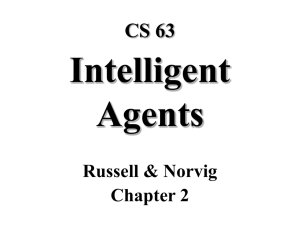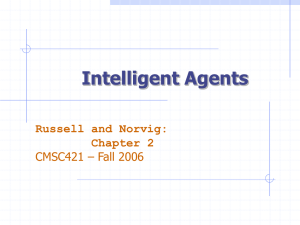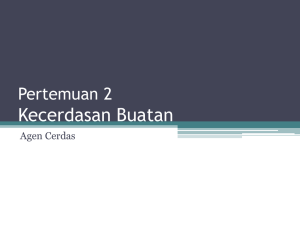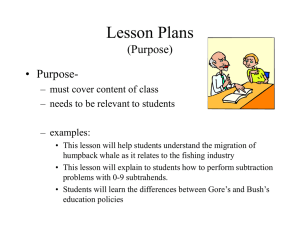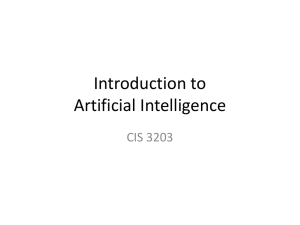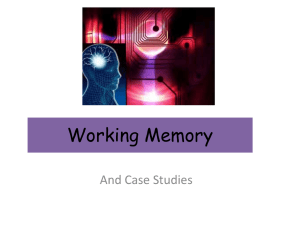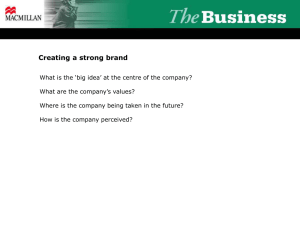Lecture Note 2
advertisement
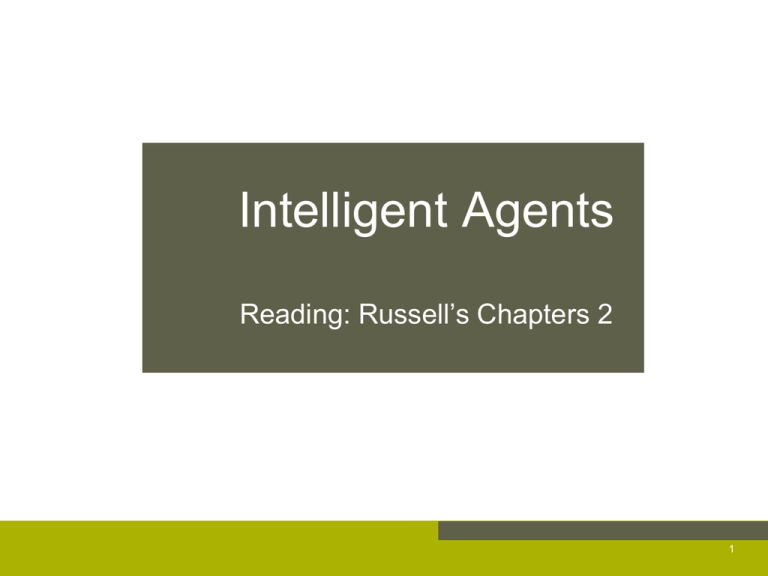
Intelligent Agents Reading: Russell’s Chapters 2 1 Agents An agent is anything that can perceive its environment through sensors and act upon that environment through actuators Human agent: eyes, ears, and other organs for sensors; hands, legs, mouth, and other body parts for actuators Robotic agent: camera and microphone for sensors; various motors for actuators 2 Agents and environments The agent function maps from percept histories to actions: [f: P* A] The agent program runs on the physical architecture to produce f 3 The vacuum-cleaner world Environment: square A and B Percepts: [location and content] e.g. [A, Dirty] Actions: left, right, suck, and no-op 4 The vacuum-cleaner world Percept sequence Action [A,Clean] Right [A, Dirty] Suck [B, Clean] Left [B, Dirty] Suck [A, Clean],[A, Clean] Right [A, Clean],[A, Dirty] Suck … … 5 The vacuum-cleaner world function REFLEX-VACUUM-AGENT ([location, status]) return an action if status == Dirty then return Suck else if location == A then return Right else if location == B then return Left 6 Rational agents For each possible percept sequence, a rational agent should select an action that is expected to maximize its performance measure, given the evidence provided by the percept sequence, and whatever built-in knowledge the agent has. E.g., performance measure of a vacuum-cleaner agent could be amount of dirt cleaned up, amount of time taken, amount of electricity consumed, amount of noise generated, etc. Environments To design an agent we must specify its task environment. PEAS description of the task environment: – – – – Performance Environment Actuators Sensors 8 PEAS Consider, e.g., the task of designing an automated taxi driver: – – – – – – – Performance measure: Safe, fast, comfortable, maximize profits Environment: Roads, pedestrians, customers Actuators: Steering wheel, accelerator, brake, signal, horn Sensors: Cameras, sonar, speedometer, GPS, engine sensors 9 Environment types Solitaire Backgammom Intenet shopping Taxi Observable?? Deterministic?? Episodic?? Static?? Discrete?? Single-agent?? 10 Environment types Fully vs. partially observable: an environment is full observable when the sensors can detect all aspects that are relevant to the choice of action. Solitaire Backgammom Intenet shopping Taxi Observable?? Deterministic?? Episodic?? Static?? Discrete?? Single-agent?? 11 Environment types Fully vs. partially observable: an environment is full observable when the sensors can detect all aspects that are relevant to the choice of action. Observable?? Solitaire Backgammom Intenet shopping Taxi FULL FULL PARTIAL PARTIAL Deterministic?? Episodic?? Static?? Discrete?? Single-agent?? 12 Environment types Deterministic vs. stochastic: if the next environment state is completely determined by the current state the executed action then the environment is deterministic. Observable?? Solitaire Backgammom Intenet shopping Taxi FULL FULL PARTIAL PARTIAL Deterministic?? Episodic?? Static?? Discrete?? Single-agent?? 13 Environment types Deterministic vs. stochastic: if the next environment state is completely determined by the current state the executed action then the environment is deterministic. Solitaire Backgammom Intenet shopping Taxi Observable?? FULL FULL PARTIAL PARTIAL Deterministic?? YES NO YES NO Episodic?? Static?? Discrete?? Single-agent?? 14 Environment types Episodic vs. sequential: In an episodic environment, the agent’s experience is divided into atomic episodes. The choice of action depends only on the episode itself Solitaire Backgammom Intenet shopping Taxi Observable?? FULL FULL PARTIAL PARTIAL Deterministic?? YES NO YES NO Episodic?? Static?? Discrete?? Single-agent?? 15 Environment types Episodic vs. sequential: In an episodic environment, the agent’s experience is divided into atomic episodes. The choice of action depends only on the episode itself Solitaire Backgammom Intenet shopping Taxi Observable?? FULL FULL PARTIAL PARTIAL Deterministic?? YES NO YES NO Episodic?? NO NO NO NO Static?? Discrete?? Single-agent?? 16 Environment types Static vs. dynamic: If the environment can change while the agent is choosing an action, the environment is dynamic. Semi-dynamic if the agent’s performance changes even when the environment remains the same. Solitaire Backgammom Intenet shopping Taxi Observable?? FULL FULL PARTIAL PARTIAL Deterministic?? YES NO YES NO Episodic?? NO NO NO NO Static?? Discrete?? Single-agent?? 17 Environment types Static vs. dynamic: If the environment can change while the agent is choosing an action, the environment is dynamic. Semi-dynamic if the agent’s performance changes even when the environment remains the same. Solitaire Backgammom Intenet shopping Taxi Observable?? FULL FULL PARTIAL PARTIAL Deterministic?? YES NO YES NO Episodic?? NO NO NO NO Static?? YES YES SEMI NO Discrete?? Single-agent?? 18 Environment types Discrete vs. continuous: This distinction can be applied to the state of the environment, the way time is handled and to the percepts/actions of the agent. Solitaire Backgammom Intenet shopping Taxi Observable?? FULL FULL PARTIAL PARTIAL Deterministic?? YES NO YES NO Episodic?? NO NO NO NO Static?? YES YES SEMI NO Discrete?? Single-agent?? 19 Environment types Discrete vs. continuous: This distinction can be applied to the state of the environment, the way time is handled and to the percepts/actions of the agent. Solitaire Backgammom Intenet shopping Taxi Observable?? FULL FULL PARTIAL PARTIAL Deterministic?? YES NO YES NO Episodic?? NO NO NO NO Static?? YES YES SEMI NO Discrete?? YES YES YES NO Single-agent?? 20 Environment types Single vs. multi-agent: Does the environment contain other agents who are also maximizing some performance measure that depends on the current agent’s actions? Solitaire Backgammom Intenet shopping Taxi Observable?? FULL FULL PARTIAL PARTIAL Deterministic?? YES NO YES NO Episodic?? NO NO NO NO Static?? YES YES SEMI NO Discrete?? YES YES YES NO Single-agent?? 21 Environment types Single vs. multi-agent: Does the environment contain other agents who are also maximizing some performance measure that depends on the current agent’s actions? Solitaire Backgammom Intenet shopping Taxi Observable?? FULL FULL PARTIAL PARTIAL Deterministic?? YES NO YES NO Episodic?? NO NO NO NO Static?? YES YES SEMI NO Discrete?? YES YES YES NO Single-agent?? YES NO NO NO 22 Environment types The simplest environment is – Fully observable, deterministic, episodic, static, discrete and single-agent. Most real situations are: – Partially observable, stochastic, sequential, dynamic, continuous and multi-agent. 23 Agent types Function TABLE-DRIVEN_AGENT(percept) returns an action static: percepts, a sequence initially empty table, a table of actions, indexed by percept sequence append percept to the end of percepts action LOOKUP(percepts, table) return action This approach is doomed to failure Table-lookup agent Drawbacks: – Huge table – Take a long time to build the table – No autonomy – Even with learning, need a long time to learn the table entries Agent types Four basic kind of agent programs will be discussed: – – – – Simple reflex agents Model-based reflex agents Goal-based agents Utility-based agents All these can be turned into learning agents. Agent types; simple reflex Select action on the basis of only the current percept. – E.g. the vacuum-agent Large reduction in possible percept/action situations(next page). Implemented through condition-action rules – If dirty then suck 27 The vacuum-cleaner world function REFLEX-VACUUM-AGENT ([location, status]) return an action if status == Dirty then return Suck else if location == A then return Right else if location == B then return Left Reduction from 4T to 4 entries 28 Agent types; simple reflex function SIMPLE-REFLEX-AGENT(percept) returns an action static: rules, a set of condition-action rules state INTERPRET-INPUT(percept) rule RULE-MATCH(state, rule) action RULE-ACTION[rule] return action Will only work if the environment is fully observable otherwise infinite loops may occur. Agent types; reflex and state To tackle partially observable environments. – Maintain internal state Over time update state using world knowledge – How does the world change. – How do actions affect world. Model of World 30 Agent types; reflex and state function REFLEX-AGENT-WITH-STATE(percept) returns an action static: rules, a set of condition-action rules state, a description of the current world state action, the most recent action. state UPDATE-STATE(state, action, percept) rule RULE-MATCH(state, rule) action RULE-ACTION[rule] return action Agent types; goal-based The agent needs a goal to know which situations are desirable. – Things become difficult when long sequences of actions are required to find the goal. Typically investigated in search and planning research. Major difference: future is taken into account 32 Agent types; utility-based Certain goals can be reached in different ways. – Some are better, have a higher utility. Utility function maps a (sequence of) state(s) onto a real number. Improves on goals: – Selecting between conflicting goals – Select appropriately between several goals based on likelihood of success. 33 Agent types; learning All previous agent-programs describe methods for selecting actions. – Yet it does not explain the origin of these programs. – Learning mechanisms can be used to perform this task. – Teach them instead of instructing them. – Advantage is the robustness of the program toward initially unknown environments. 34 Agent types; learning Learning element: introduce improvements in performance element. – Critic provides feedback on agents performance based on fixed performance standard. Performance element: selecting actions based on percepts. – Corresponds to the previous agent programs Problem generator: suggests actions that will lead to new and informative experiences. – Exploration vs. exploitation 35
